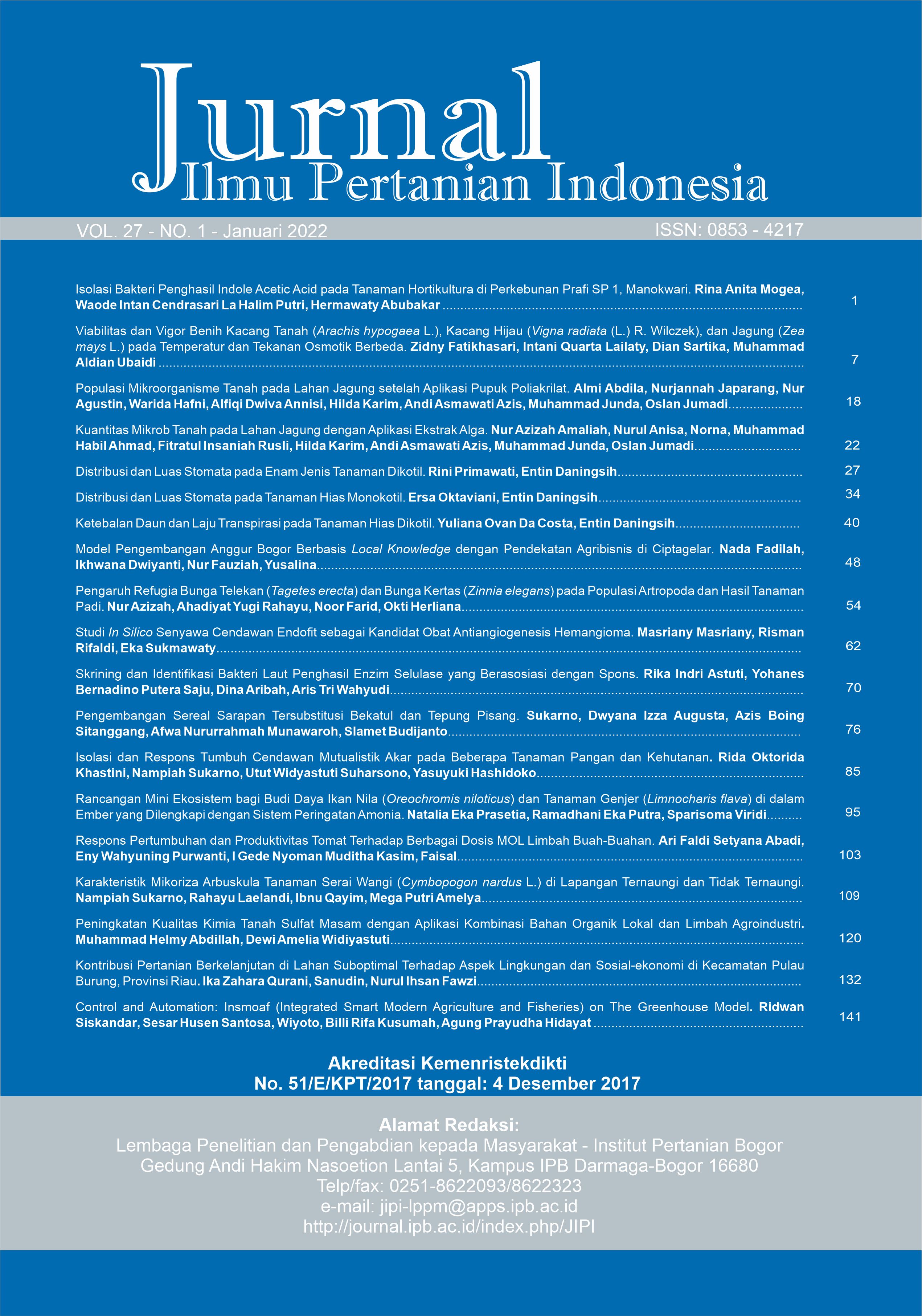Kuantitas Mikrob Tanah pada Lahan Jagung dengan Aplikasi Ekstrak Alga
Abstract
Organic fertilizers contain complete nutrients needed by plants, such as humic acid and fulvic acid, that can promote plant growth and increase the population of beneficial microbes in the soil. Algae can be an organic fertilizer in extract preparations that can increase plant growth and improve soil composition. The calculated number of microbes from the soil on corn land with the application of algae extracts affects the population of soil microbes both by standard plate count (SPC) and most probable number (MPN) methods. The total number of bacteria by SPC in the control soil was 3.1 × 105 CFU/g, while the total fungus was only 1.7 × 104 CFU/g upon applying 5% algae extract. The most microalgae by MPN in the control ground was estimated to be 2.6 × 104 cells/g. Therefore, the application of algae extract affects the number of soil microbes on corn land compared to control soil. The algae extract reduces the number of bacteria and algae but increases the number of fungi on cornfields.
Keywords: algae extracts, cornfields, soil microbes
Downloads
References
Adiguna GS, Pramesti R, Susanto AB. 2014. Kajian Pemanfaatan Limbah Padat Industri Pengolahan Agar-agar Kertas Berbahan Baku Rumput Laut Gracilaria Sp. sebagai Pupuk pada Tanaman Bayam (Amaranthus Sp.). Jurnal Of Marine Research. 3(01): 37‒43.
Asriyana dan Yuliana. 2012. Produktifitas Perairan. Jakarta (ID): Bumi Aksara
Ed-Har AA, Widyastuti R, Djajakirana G. 2017. Isolasi Dan Identifikasi Mikroba Tanah Pendegradasi Selulosa Dan Pektin Dari Rhizosfer Aquilaria malaccensis. Jurnal Buletin Tanah dan Lahan. 1: 58‒64.
Eyras MC, Rostagno CM, Defossé GE. 1998. Biological Evaluation of Seaweed Composting. Journal Agricultrue. 16(04): 119‒124. https:// doi.org/10.1080/1065657X.1998.10701943
Haryanti AM, Darmanti S, Izzati M. 2008. Kapasitas Penyerapan dan Penyimpanan Air pada Berbagai Ukuran Potongan Rumput Laut Gracilaria verrucosa sebagai Bahan Dasar Pupuk Organik. BIOMA. 10(01): 1‒6. https://doi.org/10.14710/bioma.10. 1.1-6
Kartika E, Gani Z, Kurniawan D. 2013. Tanggapan Tanaman Tomat (Lycopersicum esculentum. Mill) Terhadap Pemberian Kombinasi Pupuk Organik dan Pupuk Anorganik. Artikel Ilmiah. 2: 122‒131.
Kepel RC, Mantiri DMH, Rumengan A, Nasprianto. 2018. Biodiversitas Makroalga Di Perairan Pesisi Desa Blongko Kecamatan Sinonsayang, Kabupaten Minahasa Selatan. Jurnal Ilmiah Platax. 6(1): 175. https://doi.org/10.35800/jip.6.1. 2018.19583
Kuehn KA, Francoeur SN, Findlay RH, Neely RK. (2014) Priming in the microbial landscape: periphytic algal stimulation of litter-associated microbial decomposers. Ecology. 95: 749–762. https://doi.org/10.1890/13-0430.1
Kuwada K, Wamocho LS, Utamura M, Matsushita I, Ishii T. (2006). Effect of Red and Green Algal Extracts on Hyphal Growth of Arbuscular Mycorrhizal Fungi, and on Mycorrhizal Development and Growth of Papaya and Passionfruit. Agronomy Journal. 98(5): 1340‒1344. https://doi.org/10.2134/agronj2005.0354
Magnet MDMH, Arongozeb ND, Khan GM, Ahmed Z. 2013. Isolation And Identification Of Different Bacteria From Different Types Of Burn Wound Infections And Study Their Antimicrobial Sensitivity Pattern. IMPACT: International Journal of Research in Applied, Natural and Social Sciences. 1: 125‒132.
Mageswaran R, Sivasubramaniam S.1984. Mineral and Protein Content of some Marine Algae from Coastal Area of Northen Sri Lanka. Journal of the National Science Foundation of Sri Lanka. 12(2): 179‒189. https://doi.org/10.4038/jnsfsr.v12i2. 8356
Nugraheni A, Winata A. 2003. Konservasi Lingkungan dan Plasma Nutfah Menurut Kearifan Tradisional Masyarakat Kasepuhan Gunung Halimun. Jurnal Studi Indonesia. 13(2): 126‒143.
Neely RK, Wetzel RG. (1995) Simultaneous use of 14C and 3H to deter- mine autotrophic production and bacterial protein production in periphyton. Microbial Ecology. 30: 227–2. https://doi.org/10.1007/ BF00171931
Novizan. 2002. Petunjuk Pemupukan yang Efektif. Depok (ID): Agromedia Pustaka.
Ojo OI, Olajire-Ajayi BL, Dada OV, OM W. 2015. Effects Of Fertilizers On Soil's Microbial Growth And Populations: A Review. American Journal of Engineering Research. 4(7): 52‒61.
Patahiruddin. 2018. Analisis Kandungan Nitrat Dan Phosfat Di Tambak Berbeda Terhadap Pertumbuhan Rumput Laut (Gracilaria verrucosa (Hudson) Papenfuss). Jurnal Phinisi. 12(3): 2. https://doi.org/10.31227/osf.io/xwh6r
Pepper IL, Gerba CP. 2004. Enviromental Microbiology: A Laboratory Manual. United States (US): Elsevier Academic Press.
Rajiman. 2020. Pengantar Pemupukan. Yogyakarta (ID): Cv. Budi Utama.
Roger PA, Grant LF, Reddy PM. 1985. Blue-Green Algae In India: report. Internasional Rice Research Institute. Manila. Dalam Whitton, B.A. dan Roger, P.A. 1989. Use Of Blue- Green Algae And Azollae In Rice Culture. Society For General Microbiology: Microbial Inoculation Of Crop Plants. 25: 89‒100.
Safinaz AF, Ragaa AH. 2013. Effect Of Some Red Marine Algae As Biofertilizers On Growth Of Maize (Zea Mayz L.) Plants. International Food Research Journal. 20(4): 1629‒1632.
Scott JT, Doyle RD. (2006) Coupled photosynthesis and heterotrophic bacterial biomass production in a nutrient-limited wetland periphyton mat. Aquatic Microbial Ecology. 45: 69–77. https://doi.org/ 10.3354/ame045069
Simanungkalit RDM, Suriadikarta DA, Saraswati R, Setyorini D, Hartatik W. 2006. Pupuk Organik dan Pupuk Hayati. Bogor (ID): Balai Besar Penelitian dan Pengembangan Seumberdaya Lahan Pertanian.
Wyatt KH, Turetsky MR, Aerts R. 2015. Algae Alleviate Carbon Limitation Of Heterotrophic Bacteria In A Boreal Peatland. Journal of Ecology. 103(5): 1165‒1171. https://doi.org/10.1111/1365-2745.12455
This journal is published under the terms of the Creative Commons Attribution-NonCommercial 4.0 International License. Authors who publish with this journal agree to the following terms: Authors retain copyright and grant the journal right of first publication with the work simultaneously licensed under a Creative Commons Attribution-NonCommercial 4.0 International License. Attribution — You must give appropriate credit, provide a link to the license, and indicate if changes were made. You may do so in any reasonable manner, but not in any way that suggests the licensor endorses you or your use. NonCommercial — You may not use the material for commercial purposes.























